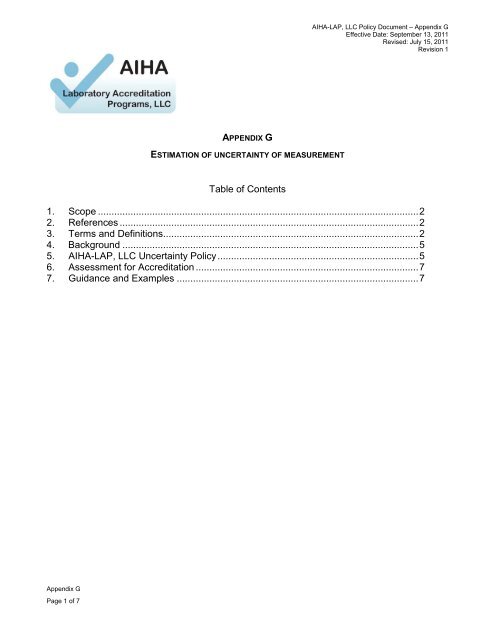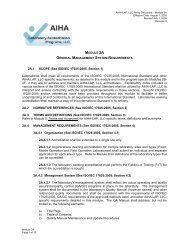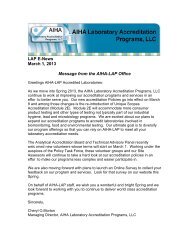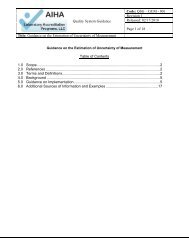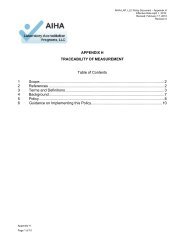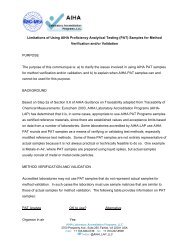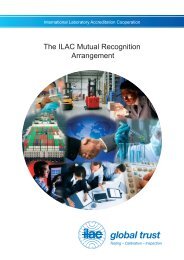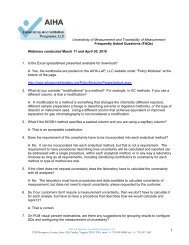Table of Contents 1. Scope - AIHA's Laboratory Accreditation ...
Table of Contents 1. Scope - AIHA's Laboratory Accreditation ...
Table of Contents 1. Scope - AIHA's Laboratory Accreditation ...
You also want an ePaper? Increase the reach of your titles
YUMPU automatically turns print PDFs into web optimized ePapers that Google loves.
AIHA-LAP, LLC Policy Document – Appendix GEffective Date: September 13, 2011Revised: July 15, 2011Revision 1APPENDIX GESTIMATION OF UNCERTAINTY OF MEASUREMENT<strong>Table</strong> <strong>of</strong> <strong>Contents</strong><strong>1.</strong> <strong>Scope</strong> ...................................................................................................................... 22. References .............................................................................................................. 23. Terms and Definitions .............................................................................................. 24. Background ............................................................................................................. 55. AIHA-LAP, LLC Uncertainty Policy .......................................................................... 56. Assessment for <strong>Accreditation</strong> .................................................................................. 77. Guidance and Examples ......................................................................................... 7Appendix GPage 1 <strong>of</strong> 7
AIHA-LAP, LLC Policy Document – Appendix GEffective Date: September 13, 2011Revised: July 15, 2011Revision 1<strong>1.</strong> SCOPEThis AIHA-LAP, LLC Policy documents the requirements for accredited laboratories to maintainaccreditation to ISO/IEC 17025 with regard to estimation <strong>of</strong> the uncertainty <strong>of</strong> measurement. Thispolicy applies to all laboratories accredited by the AIHA-LAP, LLC. AIHA-LAP, LLC wishes to thankand acknowledge the Canadian Association for <strong>Laboratory</strong> <strong>Accreditation</strong> (CALA) for its permission toincorporate elements <strong>of</strong> CALA P19 – CALA Policy on the Estimation <strong>of</strong> Uncertainty <strong>of</strong> Measurement inEnvironmental Testing in preparing this policy document.2. REFERENCESThe following documents provide the basis and assist with application <strong>of</strong> the principles stated in thispolicy.• APLAC TC 005 (2006) Interpretation and Guidance on the Estimation <strong>of</strong> Uncertainty <strong>of</strong>Measurement in Testing, Asia-Pacific <strong>Laboratory</strong> Cooperation,http://www.aplac.org/documents/tc/tc_005.pdf.• CALA P19 – CALA Policy on the Estimation <strong>of</strong> Uncertainty <strong>of</strong> Measurement in EnvironmentalTesting, http://www.cala.ca/P19_CALA_Unce_Pol.pdf• Guide to the Uncertainty <strong>of</strong> Measurement (GUM) published by ISO, IEC, CIPM, BIPM,Eurachem, etc• ILAC Guide 17: Introducing the Concept <strong>of</strong> Uncertainty <strong>of</strong> Measurement in Testing inAssociation with the Application <strong>of</strong> the Standard ISO/IEC 17025. 2002, ILAC: Rhodes, NSW,Australia, http://www.ilac.org/documents/ILAC_G17-2002_intro_the_concept_<strong>of</strong>_uncert_meas_with_17025.pdf• International vocabulary <strong>of</strong> metrology — Basic and general concepts and associatedterms (VIM), JCGM 200:2008, BIPM, IEC, IFCC, ILAC, ISO, IUPAC and OIML,http://www.bipm.org/utils/common/documents/jcgm/JCGM_200_2008.pdf.• ISO/IEC 17025:2005 - General Requirements for the Competence <strong>of</strong> Testing and CalibrationLaboratories• Quantifying Uncertainty in Analytical Measurement, 2 nd Edition, 2000, Eurachem/CITAC,http://www.eurachem.org/guides/QUAM2000-<strong>1.</strong>pdf.3. TERMS AND DEFINITIONSBias (VIM 2.18 JCGM 200:2008): estimate <strong>of</strong> a systematic measurement errorAppendix GPage 2 <strong>of</strong> 7
AIHA-LAP, LLC Policy Document – Appendix GEffective Date: September 13, 2011Revised: July 15, 2011Revision 1NOTE: Bias is the total systematic error as contrasted to random error. There may be one ormore systematic error components contributing to the bias. A larger systematic difference fromthe accepted reference value is reflected by a larger bias value.Combined standard uncertainty (VIM 2.31 JCGM 200:2008): standard measurementuncertainty that is obtained using the individual standard measurement uncertaintiesassociated with the input quantities in a measurement modelCoverage factor (VIM 2.38 JCGM 200:2008): number larger than one by which a combinedstandard measurement uncertainty is multiplied to obtain an expanded measurementuncertaintyNOTE A coverage factor, k, is typically in the range <strong>of</strong> 2 to 3.Coverage probability (VIM 2.37 JCGM 200:2008): probability that the set <strong>of</strong> true quantityvalues <strong>of</strong> a measurand is contained within a specified coverage intervalNOTE 1 This definition pertains to the Uncertainty Approach as presented in the GUM.NOTE 2 The coverage probability is also termed “level <strong>of</strong> confidence” in the GUMExpanded uncertainty (VIM 2.35 JCGM 200:2008): product <strong>of</strong> a combined standardmeasurement uncertainty and a factor larger than the number oneNOTE 1 The factor depends upon the type <strong>of</strong> probability distribution <strong>of</strong> the output quantity in ameasurement model and on the selected coverage probability.NOTE 2 The term “factor” in this definition refers to a coverage factor.NOTE 3 Expanded measurement uncertainty is termed “overall uncertainty” in paragraph 5 <strong>of</strong>Recommendation INC-1 (1980) (see the GUM) and simply “uncertainty” in IEC documents.Level <strong>of</strong> confidence GUM term used for Coverage ProbabilityNOTE The value is <strong>of</strong>ten expressed as a percentage.Measurand (VIM 2.3 JCGM 200:2008): quantity intended to be measuredNOTE The specification <strong>of</strong> a measurand requires knowledge <strong>of</strong> the kind <strong>of</strong> quantity, description<strong>of</strong> the state <strong>of</strong> the phenomenon, body, or substance carrying the quantity, including any relevantcomponent, and the chemical entities involved.NOTE In chemistry, “analyte”, or the name <strong>of</strong> a substance or compound, are terms sometimesused for ‘measurand’. This usage is erroneous because these terms do not refer to quantities.Measurement (VIM 2.1 JCGM 200:2008): process <strong>of</strong> experimentally obtaining one or morequantity values that can reasonably be attributed to a quantityNOTE 1 Measurement does not apply to nominal properties.NOTE 2 Measurement implies comparison <strong>of</strong> quantities and includes counting <strong>of</strong> entities.Appendix GPage 3 <strong>of</strong> 7
AIHA-LAP, LLC Policy Document – Appendix GEffective Date: September 13, 2011Revised: July 15, 2011Revision 1NOTE 3 Measurement presupposes a description <strong>of</strong> the quantity commensurate with theintended use <strong>of</strong> a measurement result, a measurement procedure, and a calibratedmeasuring system operating according to the specified measurement procedure, including theconditions standard uncertainty (VIM 2.30 JCGM 200:2008): measurement uncertaintyas a standard deviationType A evaluation <strong>of</strong> measurement uncertainty (VIM 2.28 JCGM 200:2008): evaluation <strong>of</strong> acomponent <strong>of</strong> measurement uncertainty by a statistical analysis <strong>of</strong> measured quantityvalues obtained under defined measurement conditionsNOTE For various types <strong>of</strong> measurement conditions, see repeatability condition <strong>of</strong>measurement, intermediate precision condition <strong>of</strong> measurement, and reproducibilitycondition <strong>of</strong> measurement.Type B evaluation <strong>of</strong> measurement uncertainty (VIM 2.29 JCGM 200:2008): evaluation <strong>of</strong> acomponent <strong>of</strong> measurement uncertainty determined by means other than a Type Aevaluation <strong>of</strong> measurement uncertaintyEXAMPLES Evaluation based on information— associated with authoritative published quantity values,— associated with the quantity value <strong>of</strong> a certified reference material,— obtained from a calibration certificate,— about drift,— obtained from the accuracy class <strong>of</strong> a verified measuring instrument,— obtained from a limits deduced through personal experience.Uncertainty <strong>of</strong> measurement (VIM 2.26 JCGM 200:2008): non-negative parametercharacterizing the dispersion <strong>of</strong> the quantity values being attributed to a measurand, based onthe information usedNOTE 1 Measurement uncertainty includes components arising from systematic effects, such ascomponents associated with corrections and the assigned quantity values <strong>of</strong> measurementstandards, as well as the definitional uncertainty. Sometimes estimated systematic effects arenot corrected for but, instead, associated measurement uncertainty components are incorporated.NOTE 2 The parameter may be, for example, a standard deviation called standardmeasurement uncertainty (or a specified multiple <strong>of</strong> it), or the half-width <strong>of</strong> an interval having astated coverage probability.NOTE 3 Measurement uncertainty comprises, in general, many components. Some <strong>of</strong> these maybe evaluated by Type A evaluation <strong>of</strong> measurement uncertainty from the statistical distribution<strong>of</strong> the quantity values from series <strong>of</strong> measurements and can be characterized by standarddeviations. The other components, which may be evaluated by Type B evaluation <strong>of</strong>measurement uncertainty, can also be characterized by standard deviations, evaluated fromprobability density functions based on experience or other information.NOTE 4 In general, for a given set <strong>of</strong> information, it is understood that the measurementuncertainty is associated with a stated quantity value attributed to the measurand. A modification<strong>of</strong> this value results in a modification <strong>of</strong> the associated uncertainty.Appendix GPage 4 <strong>of</strong> 7
AIHA-LAP, LLC Policy Document – Appendix GEffective Date: September 13, 2011Revised: July 15, 2011Revision 14. BACKGROUNDKnowledge <strong>of</strong> the uncertainty <strong>of</strong> measurement <strong>of</strong> test results is important for laboratories, their clientsand regulators. Laboratories must understand the performance <strong>of</strong> their test methods and theuncertainty associated with test results to ensure their test results meet their clients’ needs. Thereforethe measurement uncertainty process must be incorporated into method validation or verificationexercises. Clients use test results to make rational, cost effective decisions and need to understandthe reliability <strong>of</strong> the test results especially as they approach regulatory limits. Regulatory agenciesneed to understand the impact and risk <strong>of</strong> the test results reported to them.The understanding <strong>of</strong> uncertainty has changed in the analytical laboratory community in recent years.ISO/IEC 17025 contains specific requirements for the estimation and reporting <strong>of</strong> uncertainty <strong>of</strong>measurement (or measurement uncertainty) for testing and calibration activities and is the drivingforce behind the developments over the past decade. The degree <strong>of</strong> rigor needed in an estimation <strong>of</strong>uncertainty <strong>of</strong> measurement will depend on such factors as the requirements <strong>of</strong> the test method, therequirements <strong>of</strong> the client and the existence <strong>of</strong> narrow limits on which decisions on conformance to aspecification are based. It is recognized that clients and regulatory agencies are not consistent in theirknowledge or use <strong>of</strong> measurement uncertainty estimations, however this is expected to change overtime.This AIHA-LAP, LLC policy complies with the requirements <strong>of</strong> ISO/IEC 17025 and the policies andguidance provided by APLAC and ILAC. The AIHA-LAP, LLC provides examples for commonapproaches used in different disciplines in a separate guidance document. However the examples arenot exhaustive nor can they include every valid or reasonable approach. Several organizations andgroups have published guidance and worked examples on the estimation <strong>of</strong> measurementuncertainty. Laboratories are encouraged to review many sources for examples <strong>of</strong> other statisticallyvalid approaches that pertain to their activities. Refer to the AIHA-LAP, LLC Guidance on theEstimation <strong>of</strong> Uncertainty <strong>of</strong> Measurement document for a list <strong>of</strong> sources.5. ESTIMATION OF UNCERTAINTY OF MEASUREMENT POLICYThe requirement which underlies this policy is given in ISO/IEC 17025, Clauses 5.4.6 and 5.10.3.1 c).Laboratories accredited under the AIHA-LAP, LLC <strong>Accreditation</strong> Program shall fulfil the followingrequirements with respect to the estimation <strong>of</strong> uncertainty <strong>of</strong> measurement for tests associated withtheir scope <strong>of</strong> accreditation:5.1 Laboratories shall be able to demonstrate their ability to estimate measurement uncertaintyfor all accredited quantitative test methods. In those cases where a rigorous estimation is notpossible, the laboratory must make a reasonable attempt to estimate the uncertainty <strong>of</strong> testresults. All approaches that provide a reasonable and valid estimation <strong>of</strong> uncertainty are equallyacceptable.Appendix GPage 5 <strong>of</strong> 7
AIHA-LAP, LLC Policy Document – Appendix GEffective Date: September 13, 2011Revised: July 15, 2011Revision 15.2 Laboratories shall make independent estimations <strong>of</strong> uncertainty for tests performed onsamples with significantly different matrices. For example, estimations made for filter samplescannot be applied to bulk samples.5.3 Estimations <strong>of</strong> measurement uncertainty are not needed where the reported test results arequalitative. Laboratories are, however, expected to have an understanding <strong>of</strong> the contributors tovariability <strong>of</strong> test results. Examples <strong>of</strong> such tests are those that report only organismidentifications or presence/absence.5.4 Laboratories shall have a written procedure describing the process used to estimatemeasurement uncertainty, including at a minimum:5.4.1 Definition <strong>of</strong> the measurand.5.4.2 Identification <strong>of</strong> the contributors to uncertainly.5.4.3 Details <strong>of</strong> the approaches used for estimating measurement uncertainty, suchas Type A and/or Type B.When using the Type A approach, laboratories shall utilize one or more <strong>of</strong> the followingoptions. These options are generally considered from 1) most suitable, to 4) leastsuitable:1) Uncertainty specified within a standard method. In those cases where a wellrecognizedtest method (such as a peer-reviewed AOAC, NIOSH, OSHA,ASTM, etc. method), specifies limits to the values <strong>of</strong> the major sources <strong>of</strong>uncertainty <strong>of</strong> measurement and specifies the form <strong>of</strong> presentation <strong>of</strong> calculatedresults, laboratories need not do anything more than follow the reportinginstructions as long as they can demonstrate they follow the reference methodwithout modification and can meet the specified reliability.2) <strong>Laboratory</strong> Control Samples (LCS) and Matrix Spikes. In cases where matrixspecific LCS (CRM or media spikes) and/or matrix spike data are available,include uncertainty estimated from the standard deviation <strong>of</strong> long term datacollected from routine sample runs for existing test methods or from thestandard deviation <strong>of</strong> the LCS or matrix spike data for methodvalidation/verification studies for new test methods.3) Duplicate Data. In cases where sub-sampling occurs and there are data overthe reporting limit, include uncertainty estimated from long term duplicate datacollected from routine sample runs for existing test methods or methodvalidation/verification studies for new test methods.Appendix GPage 6 <strong>of</strong> 7
AIHA-LAP, LLC Policy Document – Appendix GEffective Date: September 13, 2011Revised: July 15, 2011Revision 14) Pr<strong>of</strong>iciency Testing (PT) Sample Data. In cases where the previous options arenot available and where PT samples are analyzed with sufficient data above thereporting limit, pooled PT sample data can be used to estimate uncertainty.5.4.4 Identification <strong>of</strong> the contributors <strong>of</strong> variability for qualitative test methods.5.4.5 All calculations used to estimate measurement uncertainty and bias.5.4.6 The reporting procedure.5.5 Laboratories are required to re-estimate measurement uncertainty when changes to theiroperations are made that may affect sources <strong>of</strong> uncertainty.5.6 Laboratories shall report the expanded measurement uncertainty, along with the reportedanalyte concentration, in the same units as analyte concentration, when:• it is relevant to the validity or application <strong>of</strong> the test results, or• a customer's instructions so requires, or• the uncertainty affects compliance to a specification limit.5.7 When reporting measurement uncertainty, the test report shall include the coverage factorand confidence level used in the estimations (typically k = approximately 2 at the 95% confidencelevel).5.8 When the test method has a known and uncorrected systematic bias, it shall be reportedseparately from the test result and uncertainty estimation, as a probable bias value.6. ASSESSMENT FOR ACCREDITATIONDuring assessment and surveillance <strong>of</strong> a laboratory, the assessor will evaluate the capability <strong>of</strong> thelaboratory to estimate the measurement uncertainty for test methods included in the laboratory’sscope <strong>of</strong> accreditation. The assessor will verify that the methods <strong>of</strong> estimation applied are valid, allsignificant contributors to uncertainty have been considered, and all the criteria <strong>of</strong> the AIHA-LAP, LLCpolicy are met.7. GUIDANCE AND EXAMPLESRefer to the AIHA-LAP, LLC Guidance on the Estimation <strong>of</strong> Uncertainty <strong>of</strong> Measurement document forsuggestions and examples for implementing the policies listed in this document and a list <strong>of</strong> helpfulreferences.Appendix GPage 7 <strong>of</strong> 7


